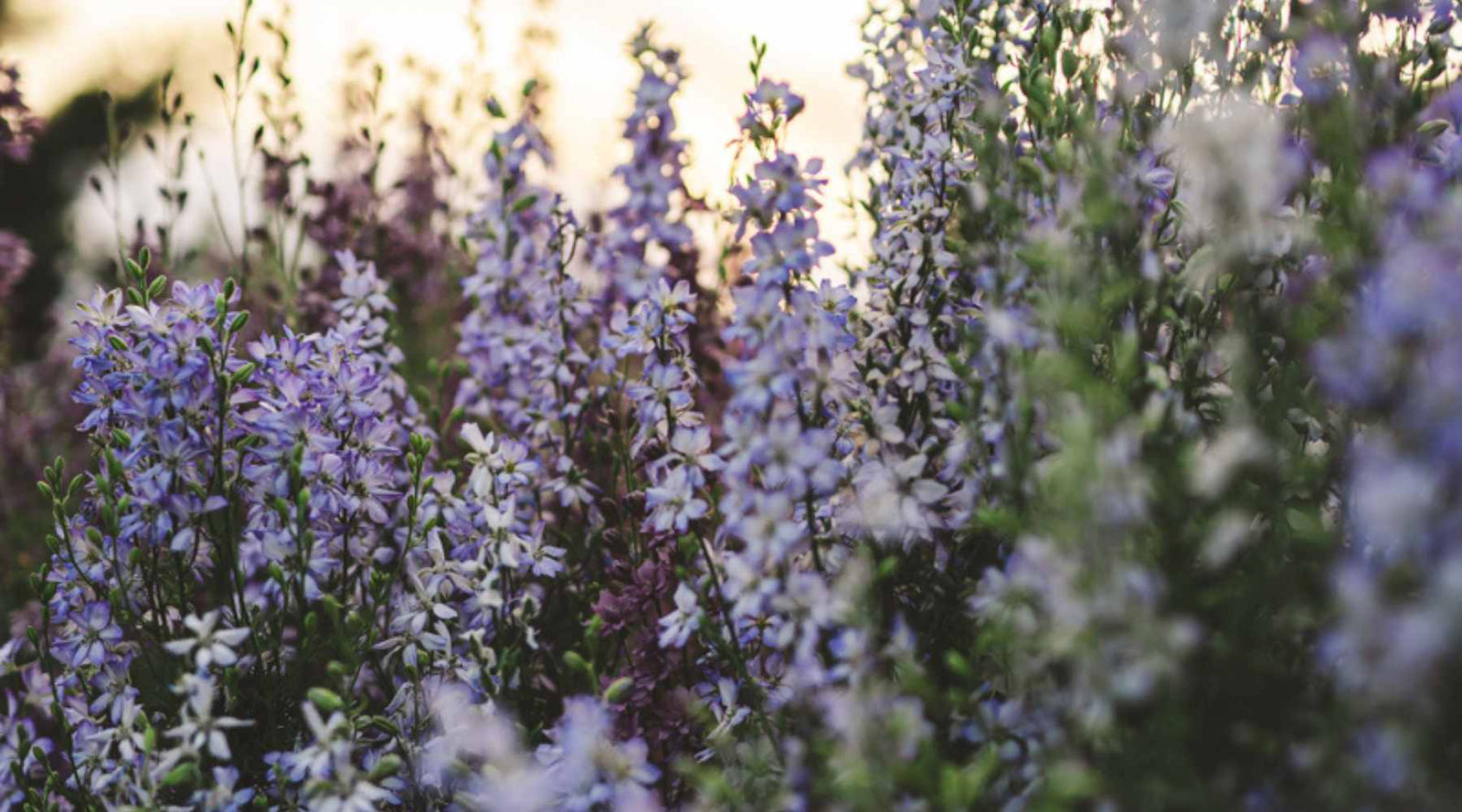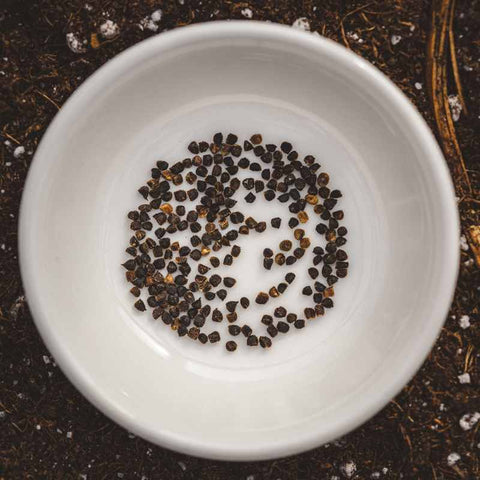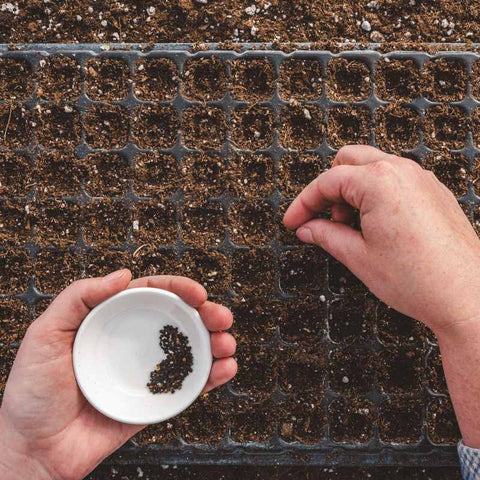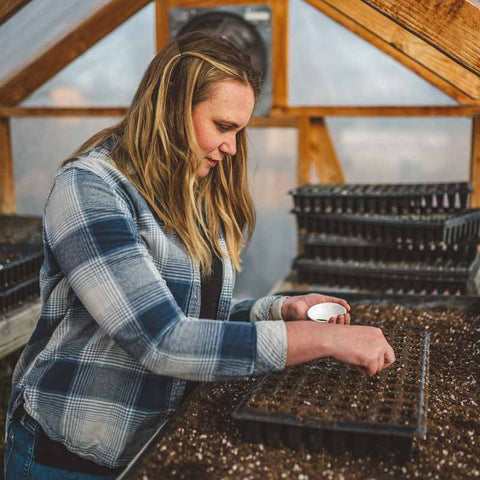20% Off USA-Made All-Metal Greenhouse Kits until May 31
20% Off USA-Made All-Metal Greenhouse Kits until May 31
Larkspur Cultivation for Flower Farmers
June 27, 2024 8 min read 0 Comments

Growing and Managing Larkspur on a Cut Flower Farm
Today, we are going to talk about how to grow and use one of my favorite early summer staple flowers: larkspur.
What is Larkspur?
Larkspur (Consolida ajacis) is a tall flower with florets running up the stalk that is available in a rainbow of colors in highly sought-after early summer palettes, even the elusive blue. We love larkspur for its slenderness that brings wispiness to our designs. It provides a more delicate look compared to similarly shaped flowers such as foxglove or snapdragons.
Larkspur is great in event work designs and mixed bouquet offerings alike. Come late June through July, we find ourselves limited in having linear flowers in the field to harvest. The snapdragons, foxglove, and stock all shut down with the summer heat thankfully, there is larkspur. Larkspur continues to thrive, providing a much-needed design component as we wait for the nicotiana and amaranth to come into bloom.
Once you get larkspur germinated, the variety is relatively fuss-free, making it a great addition to a cut flower garden. There is one thing to be aware of: all parts of the larkspur plant and its seeds are toxic. Use your discretion when growing and selling this crop.
There are some tricks to growing a successful larkspur crop, which we will share now!
How to grow Larkspur

When larkspur comes into bloom
Larkspur takes 80-90 days from germination to bloom (about 110-120 from sowing seed).
Fall planting larkspur may result in having a longer window in days to maturity since larkspur is photoperiod sensitive (triggered by daylight hours of when to bloom). Larkspur will come into bloom once the days are longer as we approach the summer solstice in June. While the other cold-loving crops tend to come to an end with the sweltering heat, larkspur comes into its own. You can elongate your harvest window with a proper start and succession planting.
When to start and plant Larkspur
Larkspur is a cold-hardy plant that actually needs the cold to grow properly, which is great news for those of us in cooler climates. Larkspur can be either direct sown into the growing beds, started from seed, or purchased as plugs from a wholesaler.
There’s a catch…
Larkspur seeds need cold stratification to break the seed’s dormancy in conjunction with needing a vernalization period (cold period) for three to four weeks to achieve long, gorgeous stems. This makes it a great crop to start in the cooler days of fall, winter and early spring to be rewarded with a bounty of stems in summer. Be warned, though, without the proper vernalization period, the plants may result in stunted growth and therefore, short stems.
This sounds much more complicated than it is; let’s walk through how to start larkspur from seed!
Growing Larkspur from Seed

Direct Sowing
If you are able, Larkspur prefers to be direct sown since it doesn’t love being transplanted. Direct-sown plants tend to be more robust. The seed is black with ridges that at first glance could almost look like a curled-up beetle. The seed’s size is large enough to be handled with fingers, but a seeder can make the task more efficient. Using a Jang seeder for succession planting your larkspur can make this quick and easy to do every couple weeks.
Larkspur can be direct sown in fall through early spring. For those of us growers who ran out of time in fall, larkspur is a great candidate for winter sowing, as long as you don’t live in too soggy of a climate. Be sure not to wait too long into the spring, especially if you are in a growing climate that brings sudden summer heat.
If you are like me and by the time you think to start Larkspur, it’s usually when the growing beds are blanketed in snow. This means I’m starting them in the greenhouse, which takes some additional steps.

Growing Larkspur Transplants
There is another thing aside from cold stratification that Larkspur seeds like for successful germination, especially when starting as transplants, and that’s darkness.
Starting Larkspur as transplants can seem tricky, but it’s usually because they are not getting the cold stratification or the darkness as needed. Ditch the heating mat and the grow lights for this crop. We need to think like nature.
Sow larkspur seeds in desired propagation trays. We use either 128-cell or 72-cell seed planting trays, being sure to plant one to two seeds per cell, about a 1/4” deep. We have also grown using the 3/4” micro soil blocks, being sure to give a healthy covering with soil on top.
Once sown, either tuck the tray in a cold, dark location below 55 degrees Fahrenheit (but not freezing) or a cooler set to about 37 degrees Fahrenheit for one to two weeks.
I have gotten great results sowing the trays and then placing them under the bottom shelf of our greenhouse, in the cooler, or in the unheated garage has worked, too. Just be sure to remember to water trays, keeping them moist but not overly saturated.
After cold stratification, it can take the seed another one to three weeks to germinate. Usually, the seeds begin to germinate for me in about two weeks. I prefer to place the seedlings, once germinated, where they get sunlight in the coolest area of our greenhouse. This is typically our bottom shelf. The key to growing healthy transplants is to provide the seedlings with a proper vernalization period of three to four weeks.
The seedlings continue to grow in the greenhouse for about a month to a month and a half. Weather cooperating, we begin planting out the transplants in late March to early April.

Succession Planting Larkspur
Larkspur is a one-cut crop, meaning it does not produce new stems like snapdragons or cosmos do. The upside is that the plant sends out multiple stems that allow you to harvest from them for a couple of weeks as they bloom.
If you want to increase the number of weeks to harvest larkspur, you can succession sow it in two-week intervals.

Planting and Maintenance
Larkspur can be planted relatively close, which is yet another reason we love them! They can be planted as close as 4”, but there is no benefit in planting them more than 9” apart. We use our most common spacing for our crops, which is 7”x 7”.
Choose a sunny location for planting since Larkspur needs a minimum of six hours of sunlight.
Larkspur doesn’t like its roots sitting in water; therefore, its chosen location should be well-draining while getting consistent watering through drip irrigation. This will keep the plant from failing or producing short stems. Keep an eye on the water levels; if the plant is beginning to look crispy, it may be under-watered. If the plant is blackening and failing, overwatering may have caused the plant to become infected with a form of root rot or black leaf spot. If infected with black leaf spot, cut back on watering, remove infected leaves, and dispose. In critical cases, removing and disposing of the plants in the trash is the best option.
Even though this crop is cold hardy, if you are growing in a climate with big temperature swings or freezes, placing them in a low tunnel made with a hoop bender with frost cloth over the transplants at the very least, can help tremendously from them getting stunted or delayed.
Larkspur can get fairly tall at 3-4 feet; because of this, horizontal trellising or corral trellising is recommended, especially if you grow in a windy climate.
Larkspur will naturally branch out; therefore, it does not need to be pinched to produce multiple stems.
Pests and diseases that affect Larkspur
Aphids are the main pest that we have battled with Larkspur on our farm. Attracting natural predators such as ladybirds helps tremendously, but if infestation is substantial, use your preferred aphid control methods as needed. Broad mites, slugs, and leaf miners are some other pests that may also cause issues with your larkspur crop.
Along with being prone to root rot and black leaf spot, larkspur is also prone to fusarium (stem canker) and powdery mildew. If you are growing in a wet, cold environment, give your plants more space to allow proper airflow to help prevent powdery mildew. Proper watering, pesticides, and fungicides can help combat these problems.

Harvesting Larkspur
Like most flowers, Larkspur is best harvested early in the morning but is forgiving if harvested later in the day.
The optimal stage of harvest is when a minimum of two florets are open up to a third of the florets being open on the stem. Past this stage, flowers begin to shatter and seed pods begin to form.
We harvest the stems to arm’s length, from the crook of our elbow down to our hand. Our standard amount of stems per bunch of Larkspur is ten stems. Have a clean bucket with water and flower preservative ready to place cut bunches directly into.
Once harvested, place Larkspur in the cooler or a cool, dark location to hydrate for a minimum of five hours before arranging. Ideally, overnight.
Harvested correctly and at the proper stage, the vase life for larkspur is 5-7 days. Larkspur does like commercial flower food.
Using Larkspur in Floral Designs
Larkspur is considered a “spike” or “line” component in design work. The role of Larkspur is to bring varying heights to keep the eye moving throughout the design, à la, an attention keeper. As discussed in the beginning, we adore Larkspur for its slenderness and the delicateness it brings to a design. Larkspur brings dimension to a design or bouquet without overpowering it. As a bonus, the Larkspur tips work beautifully in boutonnieres or corsages.
Larkspur is especially wonderful in creating an English cottage or “wildflower” aesthetic, which are both popular requests for farmer-florists. Paired with the beauties of June, such as sweet peas, peonies and ranunculus, Larkspur highlights without distracting while giving a unique experience.
Some of our Favorite Varieties of Larkspur
With a variety of colors, larkspur can work for just about any color palette. The QIS series has been reliable for white and light pink, two of our most commonly requested colors for June weddings. The QIS lilac is wonderful to use, especially for brides who want the look of lavender before it’s in bloom in our area.
Frosted Skies is a lovely mix of blue with a splash of white in the center of the florets which has become increasingly popular. In the Fancy series we adore Fancy Smokey Eyes with its unusual mauve color that sometimes can even look grey; this variety brings sophistication and depth to any design. Though we tend to focus on growing more muted tones, there are also plenty of bolder, brighter colors, such as carmine, salmon, and deep blue. Some of the varieties also act as wonderful bridge colors, such as Pink Bee larkspur with its light pink petals and white throat to help tie in a white and pink color palette seamlessly together.
Come late June through July, we use Larkspur in everything from wedding work to mixed bouquets. Larkspur can be an interchangeable variety in a humble kitchen table design or in an elegant ground arbor design. Growing larkspur can be as easy as throwing the seeds out in the growing patch, allowing nature to take care of the rest or they can be grown with a more hands-on approach to better manage the time of the harvest. Whether you are a new flower farmer or a more expert one, this is a great crop for early summer offerings.
Written by: Jessica Chase, Sierra Flower Farm, Photography by: Graham Chase, Sierra Flower Farm.
Subscribe
Sign up to get the latest on sales, new releases and more …
